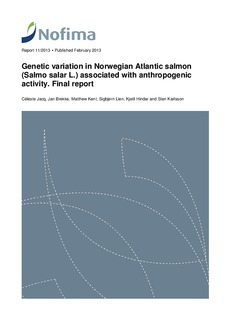Genetic variation in Norwegian Atlantic salmon (Salmo salar L.) associated with anthropogenic activity. Final report
Research report
Permanent lenke
http://hdl.handle.net/11250/286106Utgivelsesdato
2013Metadata
Vis full innførselSamlinger
Originalversjon
Nofima rapportserie. 39 p. Nofima, 2013Sammendrag
Atlantic salmon populations are affected by a number of different anthropogenic activities on local to regional scales. In a recently updated salmon register for Norway maintained by the Directorate for Nature Management (2012), the salmon populations in 54 rivers are categorised as being critically endangered or extinct in the wild. Waterway regulation and acidification are listed as being the most important cause of extinction in 23 and 14 of these rivers, respectively. Given these effects on population viability and productivity, it would be interesting to know whether it is possible to detect effects of waterway regulation and acidification at the genetic level; either through loss of genetic variability or through adaptive responses to altered selective regimes. Therefore, the aim of this study was to assess genetic variation in populations of Atlantic salmon in western Norway that have experienced environmental changes due to river acidification and waterway regulation. Genomic variation was assessed at 3761 single nucleotide polymorphism (SNP) markers in Atlantic salmon from 25 salmon populations in western and south western Norway. This study identified SNPs which differentiate samples that are affected by acidification and waterway regulation from those that are unaffected, or affected to a lesser degree. It is possible that these SNP markers differentiate the populations due to selection acting on genes closely linked to these loci; however, other mechanisms can also cause such differentiation. Although the rivers in this study were chosen based on their history of acidification and/or regulation, it is likely that these rivers have been affected by other anthropogenic factors. The scope of the present study did not allow for accurate testing of selection of these markers due to the lack of historical samples and low sample sizes, however selection cannot be excluded as the cause of genetic differentiation. In order to determine the fitness consequences in populations of Atlantic salmon affected by these studied anthropogenic activities, it will be necessary to include more samples from a greater distribution to estimate population size changes and changes in genetic variation over a temporal time scale.
Beskrivelse
-
